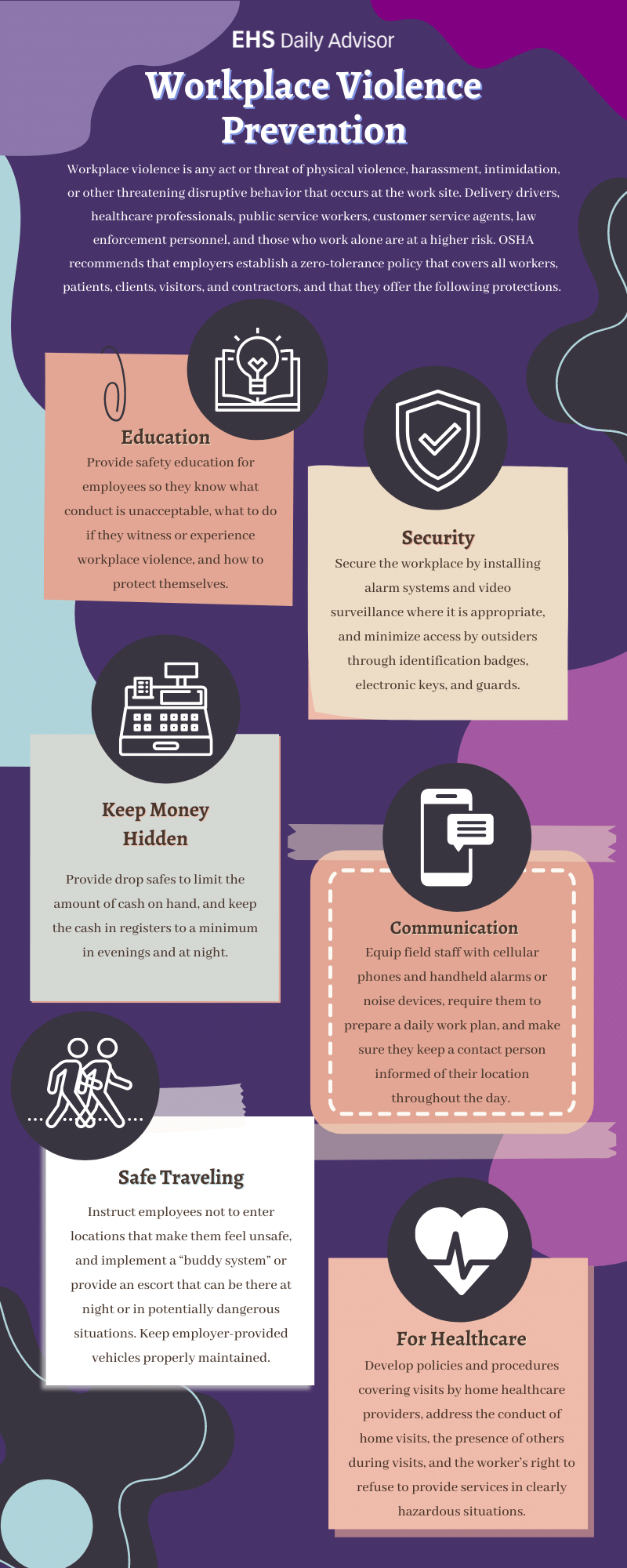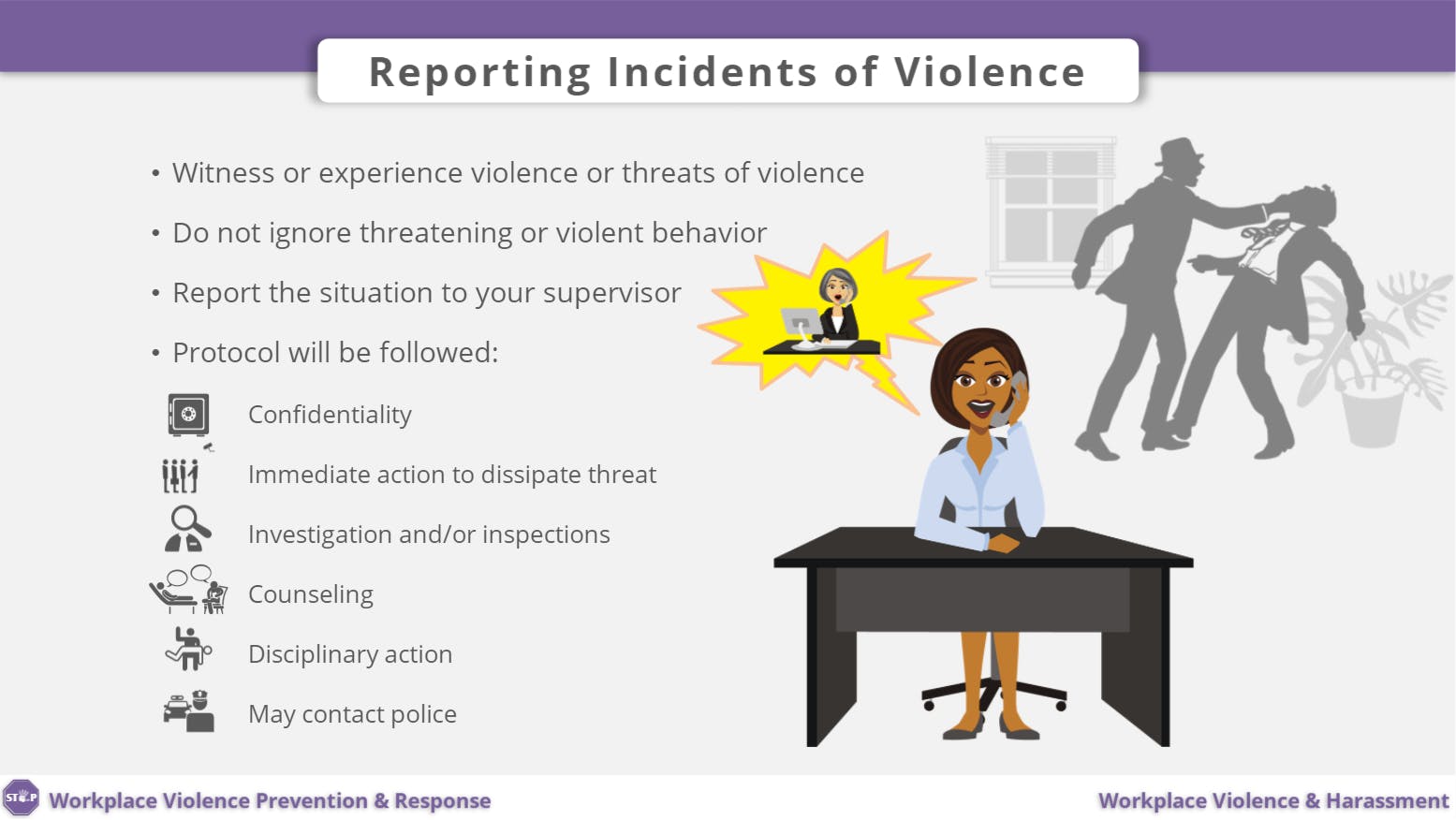Ingenious Tools and Resources for California Workplace Violence Prevention Success
Ingenious Tools and Resources for California Workplace Violence Prevention Success
Blog Article
The Duty of Employee Training and Understanding in Enhancing Workplace Physical Violence Avoidance Initiatives Across Numerous Industries
The combination of staff member training and understanding into work environment physical violence avoidance efforts is significantly acknowledged as a basic aspect of business safety throughout varied industries. By carrying out targeted training programs, businesses can successfully empower their workforce to recognize and deal with prospective threats before they rise. The effectiveness of these efforts usually hinges on several important variables that differ by sector, raising essential concerns regarding the versatility of training methods and their real-world effect. Recognizing these subtleties might reveal methods that can substantially enhance safety methods and worker confidence in high-risk environments.
Importance of Educating Programs
In today's dynamic workplace, the relevance of training programs can not be overstated, particularly in the context of workplace physical violence prevention. These programs function as a fundamental element in growing a safe and risk-free workplace society. By furnishing workers with the knowledge and abilities needed to recognize, minimize, and reply to prospective threats, companies can foster a setting that focuses on safety and security and wellness.
Effective training programs do even more than merely instruct; they equip employees to identify warning indications of violence, comprehend the methods for reporting occurrences, and develop methods to de-escalate potential disputes. Additionally, they infuse a sense of collective responsibility among team, urging positive involvement in maintaining a safe work environment.
Financial investment in training not only improves staff member awareness however likewise demonstrates an organization's dedication to guarding its workforce. This positive technique can lead to minimized occurrences of workplace violence, lower absence, and boosted employee morale. Eventually, thorough training programs are important to developing a resistant organizational culture that values security and promotes a healthy and balanced job setting, thereby minimizing the risk of physical violence and its linked effects.
Trick Parts of Effective Understanding
A thorough recognition program includes a number of essential components that are vital for efficiently stopping work environment violence. Initially, clear communication of treatments and plans related to workplace physical violence is vital. Employees must be educated concerning the organization's position on physical violence and the particular methods in position for reporting events.
Second, training sessions need to integrate realistic circumstances that workers might come across. This useful strategy assists employees identify cautioning signs of prospective violence and outfits them with the required abilities to de-escalate strained scenarios. Third, cultivating a supportive work environment culture is crucial; employees must feel equipped to speak out without concern of revenge.
In addition, continuous education and learning is necessary to keep recognition fresh and appropriate. Normal refresher training courses and updates on arising hazards can enhance staff members' caution and preparedness. Last but not least, incorporating responses mechanisms enables workers to share their insights and experiences, which can result in continual enhancement of understanding campaigns. By integrating these elements, organizations can produce a durable structure for preventing workplace violence, eventually adding to a safer and more productive environment for all workers.
Industry-Specific Training Approaches
Effective office physical violence avoidance training need to be tailored to the one-of-a-kind obstacles and dangers faced by specific sectors. For example, health care environments require training that resolves the high probability of encounters with aggressive people or site visitors. Programs need to concentrate on de-escalation techniques, identifying warning indications of prospective violence, and making certain personnel realize the relevance of reporting occurrences.
In contrast, retail official website setups may face different threats, such as burglary or consumer disputes. Training in these settings should stress situational recognition, action methods during emergencies, and the relevance of safeguarding cash money and belongings.
Manufacturing and building sectors provide their own threats, typically connected with interpersonal conflicts or dangerous working problems. Training in these markets should consist of methods for conflict resolution, advertising a culture of security, and urging open communication amongst staff members.
Furthermore, business workplaces might require training centered on protecting against harassment and intimidation, fostering a respectful work environment culture, and executing clear coverage systems. Each sector has to not only acknowledge its certain susceptabilities but likewise adjust training products to reverberate with the labor force effectively, guaranteeing that workers really feel complete and equipped to manage possible terrible scenarios.
Gauging Educating Effectiveness
Evaluating the you can check here influence of work environment violence avoidance training is critical for ensuring that employees are adequately prepared to take care of prospective threats. Pre- and post-training studies can evaluate changes in staff member understanding, mindsets, and behaviors worrying work environment physical violence.
Furthermore, practical analyses, such as role-playing situations or simulations, can provide understandings right into exactly how well employees use discovered abilities in real-life circumstances. Keeping an eye on event records prior to and after training can also function as a sign of performance, as a reduction in occurrences may reflect improved staff member preparedness.
Moreover, responses from participants must be systematically collected to determine locations for enhancement in training content and distribution. Carrying out follow-up assessments at normal intervals assists receive awareness and reinforces training concepts with time - california workplace violence prevention. By employing a detailed strategy to measuring training effectiveness, organizations can make sure that their office violence avoidance campaigns foster a safer atmosphere and improve general worker health
Building a Society of Security

Educating plays a pivotal role in this cultural change. Regular, thorough training sessions educate employees regarding identifying indication of discover here work environment physical violence and the ideal responses. Urging open interaction allows staff members to voice issues without concern of retribution, advertising collective obligation for security.
Additionally, integrating security right into everyday operations guarantees that it becomes a common worth as opposed to a simple compliance problem. This includes regular safety and security drills, updates on plans, and comments systems that involve staff members in safety and security conversations and improvements.
Ultimately, a durable society of security not only mitigates the threats of work environment violence but additionally boosts worker morale and efficiency. By cultivating an atmosphere where safety is an essential top priority, companies can produce resilient offices that support both specific well-being and cumulative success.
Final Thought
Finally, employee training and recognition are important parts in the prevention of office violence throughout various markets. Effective training programs, tailored to details industry demands, enhance staff members' capacity to identify and respond to possible threats. By applying thorough awareness approaches and fostering a culture of safety and security, organizations can dramatically minimize incidents of work environment physical violence and improve general staff member spirits. Commitment to continuous training and evaluation ensures sustained efficiency and flexibility in attending to arising challenges within the workplace atmosphere.

Routine, thorough training sessions educate employees concerning identifying caution indicators of work environment violence and the suitable reactions.In conclusion, employee training and recognition are essential elements in the avoidance of work environment violence across numerous markets.
Report this page